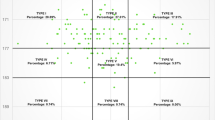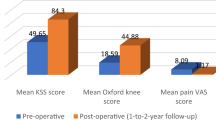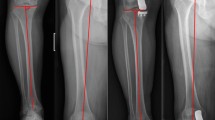Abstract
Study Background
Mechanical alignment has always been considered as the gold standard in total knee arthroplasty (TKA), but various other coronal alignment strategies have been proposed to enhance native knee kinematics and thus elevate patient satisfaction levels. Coronal plane alignment of the knee (CPAK) classification introduced by MacDessi is a simple yet comprehensive system to classify knees based on their coronal plane alignment. It categorizes knees into nine phenotypes based on medial proximal tibial angle (MPTA) and lateral distal femoral angle (LDFA).
Materials and Methods
This study investigates the distribution of classification of primary arthritic knees (CPAK) types among arthritic knees in the South Indian population and compares the functional outcomes following total knee arthroplasty (TKA) using traditional mechanical alignment among various CPAK types. The research, spanning from September 2021 to August 2023, encompasses a comprehensive analysis of 324 patients with 352 knees in the first part and 48 patients with 72 knees in the second part of the study who underwent TKA, incorporating demographic data and radiological evaluations.
Results
Results indicate a predominant distribution of CPAK type 1, followed by type 2 and type 4 among the South Indian population. In the functional outcomes analysis, regardless of CPAK type, patients exhibited significant improvements in Knee Injury and Osteoarthritis Outcome Score (KOOS), Oxford Knee Score (OKS), and visual analog scale (VAS) scores post-operatively.
Conclusion
CPAK distribution among the South Indian population is comparable to other Indian study and studies with an Asian population, but varies with studies among the White population. Significant improvement of functional outcome among all CPAK types signifies the robust nature of conventional mechanical alignment strategy. Thus, our study serves as an initial exploration into the knee phenotype of the South Indian population and findings contribute to ongoing research on optimal alignment strategies in knee arthroplasty, paving the way for future, more extensive studies in this dynamic field.

Reproduced from MacDessi SJ, Griffiths-Jones W, Harris IA, Bellemans J, Chen DB. Coronal Plane Alignment of the Knee (CPAK) classification. Bone Joint J 2021;103-B(2):329–337


Similar content being viewed by others
Data availability
None.
References
Shichman, I., Roof, M., Askew, N., Nherera, L., Rozell, J. C., Seyler, T. M., et al. (2023) Projections and epidemiology of primary hip and knee arthroplasty in medicare patients to 2040–2060. JBJS Open Access, 8(1), e22.00112.
The effect of alignment and BMI on failure of total knee replacement—PubMed [Internet]. [cited 2023 Oct 20]. https://pubmed.ncbi.nlm.nih.gov/21915573/
Werner, F. W., Ayers, D. C., Maletsky, L. P., & Rullkoetter, P. J. (2005). The effect of valgus/varus malalignment on load distribution in total knee replacements. Journal of Biomechanics, 38(2), 349–355.
Bellemans, J., Colyn, W., Vandenneucker, H., & Victor, J. (2012). The Chitranjan Ranawat award: Is neutral mechanical alignment normal for all patients? The concept of constitutional varus. Clinical Orthopaedics and Related Research, 470(1), 45–53.
Karasavvidis, T., Pagan Moldenhauer, C. A., Haddad, F. S., Hirschmann, M. T., Pagnano, M. W., & Vigdorchik, J. M. (2023) Current concepts in alignment in total knee arthroplasty. The Journal of Arthroplasty, 38(7S2), S29–S37.
MacDessi, S. J., Griffiths-Jones, W., Harris, I. A., Bellemans, J., & Chen, D. B. (2021) Coronal plane alignment of the knee (CPAK) classification. The Bone and Joint Journal, 103-B(2), 329–337.
Pagan, C. A., Karasavvidis, T., Lebrun, D. G., Jang, S. J., MacDessi, S. J., & Vigdorchik, J. M. (2023). Geographic variation in knee phenotypes based on the coronal plane alignment of the knee classification: A systematic review. Journal of Arthroplasty, 38(9), 1892-1899.e1.
Tarassoli, P., Wood, J. A., Chen, D. B., Griffiths-Jones, W., Bellemans, J., & MacDessi, S. J. (2022). Arithmetic hip-knee-ankle angle and stressed hip-knee-ankle angle: Equivalent methods for estimating constitutional lower limb alignment in kinematically aligned total knee arthroplasty. Knee Surgery, Sports Traumatology, Arthroscopy, 30(9), 2980–2990.
Toyooka, S., Osaki, Y., Masuda, H., Arai, N., Miyamoto, W., Ando, S., et al. (2023). Distribution of coronal plane alignment of the knee classification in patients with knee osteoarthritis in Japan. The Journal of Knee Surgery, 36(7), 738–743.
Hsu, C. E., Chen, C. P., Wang, S. P., Huang, J. T., Tong, K. M., & Huang, K. C. (2022). Validation and modification of the coronal plane alignment of the knee classification in the Asian population. Bone and Joint Open, 3(3), 211–217.
Sappey-Marinier, E., Batailler, C., Swan, J., Schmidt, A., Cheze, L., MacDessi, S. J., et al. (2022). Mechanical alignment for primary TKA may change both knee phenotype and joint line obliquity without influencing clinical outcomes: A study comparing restored and unrestored joint line obliquity. Knee Surgery, Sports Traumatology, Arthroscopy, 30(8), 2806–2814.
Mulpur, P., Desai, K. B., Mahajan, A., Masilamani, A. B. S., Hippalgaonkar, K., & Reddy, A. V. G. (2022). Radiological Evaluation of the phenotype of indian osteoarthritic knees based on the coronal plane alignment of the knee classification (CPAK). Indian Journal of Orthopaedics, 56(12), 2066–2076.
Steele, J. R., Jang, S. J., Brilliant, Z. R., Mayman, D. J., Sculco. P. K., Jerabek, S.A., et al. (2023) Deep learning phenotype automation and cohort analyses of 1,946 knees using the coronal plane alignment of the knee classification. The Journal of Arthroplasty, 38(6S), S215–S221.e1.
Prasanna, L. C., Bhosale, S., D’souza, A. S., Mamatha, H., Thomas, R. H., & Sachin, K. S. Facial Indices of north and south indian adults: Reliability in stature estimation and sexual dimorphism. Journal of Clinical and Diagnostic Research, 7(8), 1540–1542.
Paley, D. (2002) Radiographic assessment of lower limb deformities. In: D. Paley (Ed.), Principles of deformity correction (pp. 31–60) [Internet]. Springer: Berlin, Heidelberg. [cited 2023 Oct 20]. https://doi.org/10.1007/978-3-642-59373-4_3
MacDessi, S. J., Griffiths-Jones, W., Harris, I. A., Bellemans, J., & Chen, D. B. (2020). The arithmetic HKA (aHKA) predicts the constitutional alignment of the arthritic knee compared to the normal contralateral knee: A matched-pairs radiographic study. Bone and Joint Open, 1(7), 339–345.
Griffiths-Jones, W., Chen, D. B., Harris, I. A., Bellemans, J., & MacDessi, S. J. (2021). Arithmetic hip-knee-ankle angle (aHKA): An algorithm for estimating constitutional lower limb alignment in the arthritic patient population. Bone and Joint Open, 2(5), 351–358.
Colyn, W., Cleymans, A., Bruckers, L., Truijen, J., Smeets, K., & Bellemans, J. (2023). The pre-diseased coronal alignment can be predicted from conventional radiographs taken of the varus arthritic knee. Archives of Orthopaedic and Trauma Surgery, 143(7), 4425–4436.
Li, Y., Wang, S., Wang, Y., & Yang, M. (2018). Does kinematic alignment improve short-term functional outcomes after total knee arthroplasty compared with mechanical alignment? A systematic review and meta-analysis. The Journal of Knee Surgery, 31(1), 78–86.
Acknowledgements
None.
Funding
None.
Author information
Authors and Affiliations
Corresponding author
Ethics declarations
Conflict of Interest
We the authors declare that we have no known competing financial interests or personal relationships that could have appeared to influence the work reported in this paper.
Ethical Approval
Obtained Ref. No. 3/I/2022.
Informed Consent
Obtained.
Additional information
Publisher's Note
Springer Nature remains neutral with regard to jurisdictional claims in published maps and institutional affiliations.
Rights and permissions
Springer Nature or its licensor (e.g. a society or other partner) holds exclusive rights to this article under a publishing agreement with the author(s) or other rightsholder(s); author self-archiving of the accepted manuscript version of this article is solely governed by the terms of such publishing agreement and applicable law.
About this article
Cite this article
Palanisamy, Y., Natarajan, S., Prasad, A.R. et al. Coronal Plane Alignment Classification of Arthritic Knees in a South Indian Population and Functional Outcome Comparison Post-mechanical Alignment Total Knee Arthroplasty. JOIO (2024). https://doi.org/10.1007/s43465-024-01154-y
Received:
Accepted:
Published:
DOI: https://doi.org/10.1007/s43465-024-01154-y




